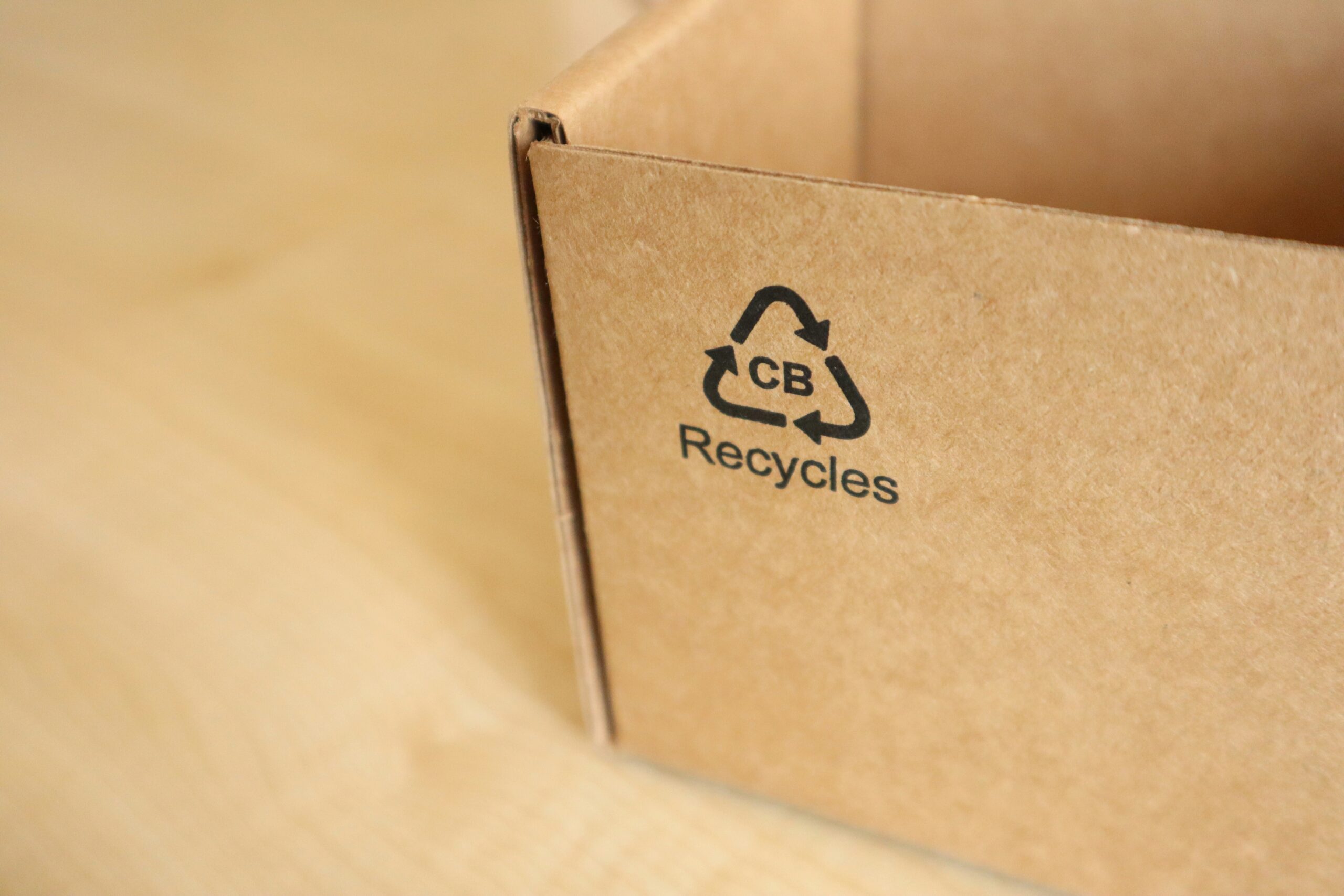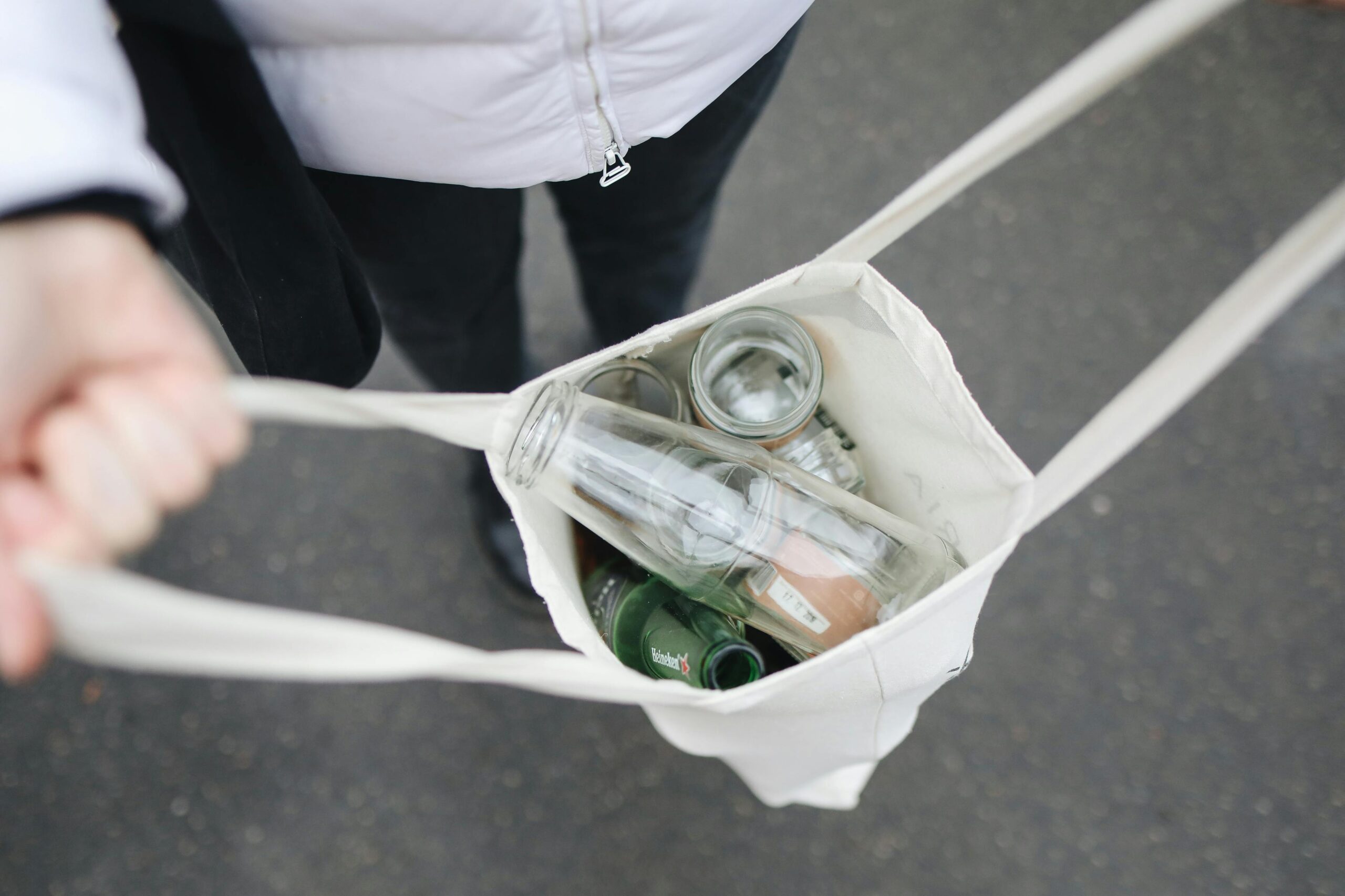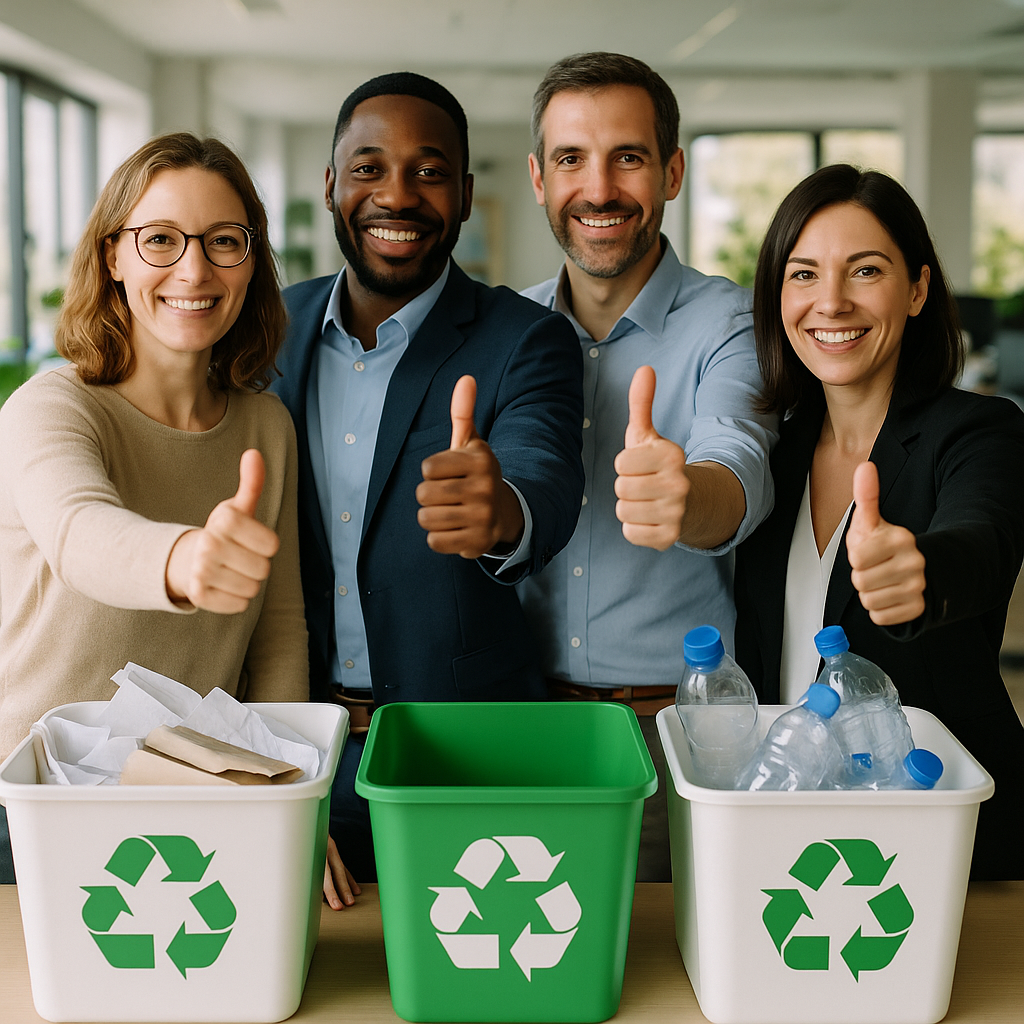5901 Botham Jean Blvd, Dallas, TX 75215
What Are the Main Types of Commercial Recyclable Materials?
July 13, 2025Every business produces waste. From offices to manufacturing facilities, commercial operations generate various materials that can be diverted from landfills through recycling. Understanding these materials is the first step toward effective waste management.
The four main types of commercial recyclable materials are paper and cardboard, plastic, glass, and metal. These constitute the core of most business recycling programs across industries. Each type requires specific handling methods to optimize recycling efficiency.
By properly identifying and sorting these recyclable materials, businesses can significantly reduce their environmental impact while potentially lowering waste disposal costs. Let’s examine these key materials that every commercial sustainability strategy should include.
How can Businesses Recycle Paper and Cardboard?

Paper and cardboard waste make up a significant portion of commercial waste streams. Office paper, newspapers, magazines, and packaging materials provide excellent recycling opportunities for businesses of any size.
Establishing an effective paper and cardboard recycling program doesn’t have to be complicated. With the right approach, businesses can reduce their environmental footprint and potentially lower waste disposal costs.
Implementing an Office Paper Recycling Program
Offices generate substantial amounts of recyclable paper. Start by placing clearly labeled recycling bins throughout your workspace. Position smaller containers at each desk and larger collection points in common areas and near printers.
Train staff on proper sorting practices to minimize contamination. Most recycling services accept white office paper, colored paper, envelopes, magazines, and newspapers. Keep a simple list of acceptable items posted near collection points for quick reference.
Encourage reducing paper waste through digital documentation where possible. When printing is necessary, make double-sided printing the default setting on all office printers. This change can cut paper usage by up to 50%.
Managing Cardboard Recycling Effectively
Businesses receiving regular shipments often accumulate large volumes of cardboard. Establish a designated area for cardboard collection, ensuring boxes are broken down and flattened to maximize storage space.
For those generating substantial cardboard waste, consider investing in a baler. These machines compact cardboard into dense, manageable bales that require less storage space and are more efficient to transport. Many recycling providers offer bale pickup services, streamlining your recycling process.
Remove contaminants like plastic tape, labels, and styrofoam inserts before recycling cardboard. Clean, sorted cardboard has greater recycling value and maintains the quality of recycled products.
Choosing the Right Collection Services
Partner with recycling providers that accept mixed paper and cardboard waste. Many commercial waste management companies offer dedicated recycling collection alongside regular waste pickup.
For larger operations, schedule regular pickups based on your volume of recyclable materials. Some providers offer on-demand services, allowing you to request collection when your storage area reaches capacity.
Request transparent reporting from your recycling partner to track waste diversion rates. This data can help measure the effectiveness of your recycling program and identify opportunities for improvement.
Engaging Employees in Recycling Efforts
Even the best-designed recycling program needs employee participation. Create clear, consistent messaging about recycling procedures and make it convenient for staff to participate.
Consider appointing recycling champions within different departments to promote proper practices. These individuals can answer questions and ensure collection points are well-maintained.
Provide regular updates on recycling success metrics. Knowing their efforts make a difference can help maintain employee enthusiasm for the program.
Environmental Benefits of Paper and Cardboard Recycling
The environmental impact of paper and cardboard recycling extends beyond just reducing landfill waste. Recycling paper conserves trees and forest resources. It takes approximately 17 trees to produce one ton of virgin paper, while recycled paper uses no new trees.
The paper recycling process uses significantly less energy and water compared to virgin paper production. Manufacturing recycled paper consumes 40% less energy and 50% less water than making paper from raw materials.
Recycling paper and cardboard also reduces greenhouse gas emissions. When paper decomposes in landfills, it produces methane, a potent greenhouse gas. Recycling prevents these emissions and reduces the energy needed for new paper production.
- Place clearly labeled recycling bins throughout your facility
- Train employees on proper sorting practices
- Set printers to double-sided printing by default
- Break down cardboard boxes to save space
- Remove non-recyclable elements like plastic tape and styrofoam
- Partner with recycling providers that accept mixed paper waste
- Track your recycling metrics to measure program success
- Recognize and reward employee participation
By implementing these straightforward strategies, businesses can establish effective paper and cardboard recycling programs that benefit both the environment and their bottom line. The key is to make recycling convenient, communicate clearly, and maintain consistency in your approach.
| Benefit | Paper Recycling | Cardboard Recycling |
|---|---|---|
| Trees Saved | Recycling one ton saves 17 trees | Each bale saves 12 trees |
| Water Saved | Saves over 7,000 gallons per ton | Saves significant water consumption in production |
| Landfill Space Saved | 3.3 cubic yards of space saved per ton | Reduces landfill space need |
| GHG Emissions Reduced | Equivalent to driving a car 3,700 miles | Reduces CO2 emissions significantly |
| Jobs Created | Supports jobs in recycling and manufacturing | Contributes to jobs in recycling chain |
What Types of Plastic can Businesses Recycle?
Businesses generate significant volumes of plastic waste through packaging, shipping materials, and everyday operations. Identifying and sorting plastics by their recycling codes is essential for effective recycling programs. Most commercial recycling centers accept several types of plastic that can be processed into new products.
Understanding Plastic Recycling Codes
Recycling codes appear as numbers inside a triangular arrow symbol on plastic items. These codes help sorting facilities identify the polymer type. For businesses, understanding these codes simplifies waste sorting and improves recycling efficiency.
Each code represents a different polymer with unique properties and recycling requirements. Commercial recycling programs typically focus on the most valuable and easily recyclable plastics, which have established markets for recycled content.
PET (Polyethylene Terephthalate) – Code #1
PET is among the most widely recycled plastics in commercial settings. Businesses commonly encounter PET in water bottles, beverage containers, and food packaging. When recycled, PET can become polyester fiber for clothing, carpet, or new containers. The recycling rate for PET bottles in the US reaches approximately 30%.
PET recycling offers significant environmental benefits. Each pound of recycled PET saves about 12,000 BTUs of energy and reduces greenhouse gas emissions compared to virgin material production. Businesses that generate large volumes of PET waste should prioritize its collection.
HDPE (High-Density Polyethylene) – Code #2
HDPE represents another highly recyclable plastic found in commercial environments. Milk jugs, detergent bottles, and plastic drums are common HDPE products. This durable plastic maintains its value in recycling streams because it can be easily processed into new containers or plastic lumber.
For businesses, natural (unpigmented) HDPE holds the highest recycling value. Colored HDPE products still have recycling markets but may have more limited applications. Businesses should separate HDPE from other plastics when possible to maximize its recycling potential.
LDPE (Low-Density Polyethylene) – Code #4
LDPE is increasingly accepted in commercial recycling programs. This flexible plastic appears in shrink wrap, plastic bags, and flexible packaging materials. Many businesses generate substantial amounts of LDPE through shipping operations and product packaging.
While historically challenging to recycle, advancements in processing technology have improved LDPE recycling rates. Businesses can now find specialized recyclers that handle commercial film and flexible packaging. Clean, dry LDPE has viable markets for products like plastic lumber, playground equipment, and new film products.
Other Recyclable Commercial Plastics
Beyond the most common recyclable plastics, businesses may also recycle PP (Polypropylene, Code #5) found in containers, caps, and industrial packaging. PP recycling is growing as sorting technologies improve and markets expand.
PVC (Polyvinyl Chloride, Code #3) and PS (Polystyrene, Code #6) present more challenges for recycling. These materials have more limited markets and may contaminate other plastic streams. Businesses should check with local recyclers about acceptance policies for these materials.
| Plastic Type | Recycling Code | Recyclability |
|---|---|---|
| PET (Polyethylene Terephthalate) | #1 | Highly recyclable; used for containers and bottles. |
| HDPE (High-Density Polyethylene) | #2 | Highly recyclable; common in milk jugs and detergent bottles. |
| LDPE (Low-Density Polyethylene) | #4 | Improved recyclability; used for plastic bags and film. |
| PP (Polypropylene) | #5 | Recycling growing; used in caps and containers. |
| PVC (Polyvinyl Chloride) | #3 | Limited recycling markets; used in pipes and profiles. |
| PS (Polystyrene) | #6 | Recyclable with challenges; used in foam and packaging. |
For effective plastic recycling, businesses should partner with recyclers who can provide guidance on sorting requirements and accepted materials. Implementing clear labeling on collection bins and training staff on proper sorting practices will significantly improve recycling outcomes. Regular waste audits can help identify opportunities to increase plastic recovery rates.
How Can Businesses Recycle Metal and Glass?

Metal and glass are among the most versatile recyclable materials in the commercial waste stream. Their unique properties allow them to be recycled indefinitely without a loss in quality, making them especially valuable for businesses aiming to enhance sustainability efforts.
Metal Recycling for Businesses
Commercial metal recycling primarily involves aluminum cans, steel containers, and various metal scraps generated during operations. Businesses produce significant quantities of recyclable metals, from food and beverage containers in break rooms to production scraps in manufacturing settings.
The metal recycling process starts with proper separation. Businesses should establish a system to distinguish ferrous metals (like steel, containing iron) from non-ferrous metals (such as aluminum and copper). A simple magnet test can assist with this—ferrous metals stick to a magnet, while non-ferrous metals do not.
Once separated, metals should be placed in designated collection bins. Many recycling service providers offer specialized containers designed for metal waste. For businesses generating large volumes of metal scrap, baling or compacting equipment can reduce storage space needs and potentially increase the value of collected materials.
Glass Recycling for Businesses
Glass recycling in commercial settings mainly includes bottles, jars, drinking glasses, and other containers. Like metal, glass can be recycled endlessly without losing its purity, making it ideal for closed-loop recycling systems.
To recycle glass effectively, businesses should first remove non-glass components such as caps, corks, or food residue. Although color sorting is helpful, modern recycling facilities can often handle mixed glass. However, specialized items like light bulbs, window glass, and ceramics usually require separate handling due to different melting points and chemical compositions.
Glass crushing equipment can be particularly useful for businesses that generate large volumes of glass waste, such as restaurants, bars, or hotels. These machines can reduce the glass volume by up to 80%, significantly reducing storage space needs and transportation costs.
Implementation Steps for Business Metal and Glass Recycling
To establish an effective metal and glass recycling program, businesses should:
- Conduct a waste audit to determine the types and volumes of metal and glass waste generated
- Place clearly labeled recycling bins in strategic locations
- Train employees on proper sorting techniques and the importance of uncontaminated recyclables
- Partner with a reputable recycling service provider specializing in commercial recycling
- Track recycling metrics to measure progress and identify areas for improvement
Large-scale operations might benefit from investing in on-site processing equipment, like balers for metal or glass crushers, to enhance efficiency and potentially generate revenue from recycled materials.
Benefits of Metal and Glass Recycling
Recycling metal and glass offers numerous advantages for businesses. Metal recycling conserves resources—recycling aluminum uses 95% less energy than production from raw materials. Similarly, using recycled glass requires about 30% less energy than manufacturing new glass.
Operationally, comprehensive recycling programs can significantly reduce waste disposal costs while potentially creating new revenue streams through recyclable material sales. Additionally, strong recycling practices enhance corporate sustainability profiles, meeting the growing expectations of environmentally conscious customers and stakeholders.
By prioritizing the recycling of materials like metal and glass, which can be recycled indefinitely, businesses contribute meaningful efforts to resource conservation while realizing tangible operational benefits.
| Recyclable Material | Requirements | Environmental Benefits |
|---|---|---|
| Metal | Separation of ferrous and non-ferrous metals; Magnet sorting; Properly labeled collection bins; Use of balers or compactors for large volumes | Conserves resources; Recycling aluminum uses 95% less energy than production from raw materials |
| Glass | Remove non-glass components; Color sorting beneficial; Optional use of glass crushers for volume reduction | Recycling requires about 30% less energy than making new glass; Can be recycled endlessly without quality degradation |
Conclusion: Maximizing commercial recycling efforts

Commercial recycling represents a strategic business decision with significant benefits. Effective recycling programs require proper material identification, consistent separation practices, and partnerships with professional recycling services. Businesses that implement comprehensive recycling initiatives for paper, plastic, metal, and glass not only reduce their environmental impact but also demonstrate corporate responsibility in concrete ways.
The benefits extend beyond environmental stewardship. Organizations prioritizing recycling often reduce operating costs through lower waste disposal fees. Many businesses can also monetize their recyclable materials through rebate programs, creating financial returns on their sustainability efforts. Contact Okon Recycling at 214-717-4083 for guidance on maximizing your recycling program’s effectiveness and discovering potential rebate opportunities for your business.
